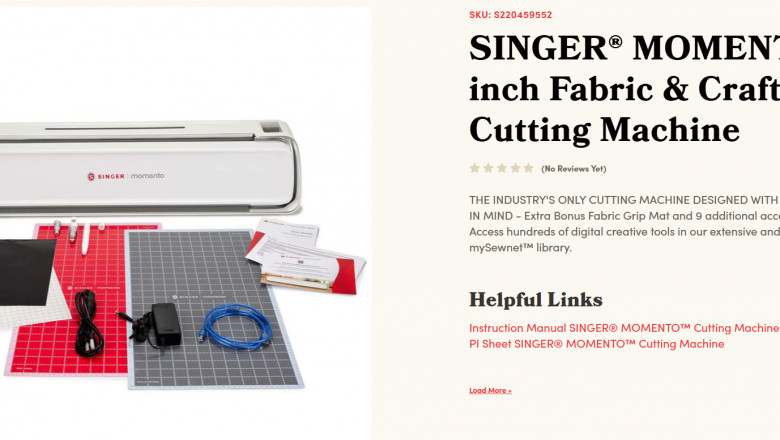views
The garment and textile industries are in the midst of a major revolution, primarily spurred by technological developments. One such technology that has revolutionised the efficiency and accuracy of fabric cutting is the incorporation of Artificial Intelligence (AI) in digital fabric cutting machines. The function of AI in cutting fabric extends further than mere automation, it maximises the process as a whole by facilitating wiser decision-making, pattern detection, and automated compensation, resulting in greater productivity, less waste, and a cleaner manufacturing process.
Computer fabric cutting machines have already transformed how fabrics are manipulated, but AI has advanced their functionality. By integrating machine learning algorithms and sophisticated software, digital cutting machines are becoming increasingly adaptable and intelligent, enabling greater pattern recognition and real-time compensation depending on material properties and cutting conditions.
Pattern Recognition and Optimisation
One of the most important functionalities that AI has to offer for digital fabric cutting machines is recognising and optimising patterns for cutting. Cutting patterns previously were done through manually programming and fine-tuning patterns, an error-prone and time-consuming task. Since AI came about, these machines are now capable of scanning and reading digital patterns with high precision, enabling the pattern to be aligned faster and more accurately.
Artificial intelligence-powered pattern recognition systems are able to detect precise design elements of the fabric, including curves, angles, and straight edges. The systems inspect the texture, weft, and elasticity of the fabric, making the cutting process ideally tailored to the material. This prevents errors from human intervention and optimizes the use of the fabric, minimizing wastage and material expenditure.
In addition, AI can optimize the layout of the cutting pattern to ensure maximum fabric utilisation. For instance, if a roll of fabric contains a specific flaw or irregularity, the AI will be able to modify the cutting plan to exclude areas of defect, thus having fewer defective pieces and more yield. This optimisation would be very difficult, if not impossible, to perform manually.
Automated Adjustments for Material Variability
Another place where AI comes into play is in the automated optimization of cutting parameters according to material variability. Fabrics are available in different textures, thicknesses, and compositions, and a single approach to cutting always results in second-best outcomes. But with AI implementation, digital fabric cutting machines can monitor the material's characteristics in real-time during the cutting process and adjust accordingly to make up for the variations.
For example, the equipment is able to sense variations in the tension of fabric, extensibility, or thickness and will automatically adjust the speed, pressure, or blade angle in response. In this way, every cut can be made to the highest standards, no matter what material is being worked with. This degree of flexibility makes it possible for producers to produce more types of material without manually readjusting extensive settings, and this takes less time as well as reduces resources.
Moreover, AI algorithms can forecast the behavior of particular fabrics under a specific situation, like hot or mechanical stress, to enable operators to choose the most appropriate cutting settings even before the process starts. This foresight helps to ensure a smoother production process and avoid unwanted fabric waste.
Real-time Data Analytics for Enhanced Decision-Making
AI’s role in real-time data analysis is another critical factor that enhances the performance of digital fabric cutting machines. Through continuous monitoring of the cutting process, AI systems collect vast amounts of data, which can be analysed to identify potential inefficiencies or quality issues. This information is then used to make informed decisions, such as adjusting cutting parameters or reconfiguring machine settings to optimise performance.
For instance, when the machine finds an anomaly in the fabric, like a defect in the stitch or an irregularity in the weave, the AI system can instantly notify operators and recommend rectification. This is a preventive measure that lessens the chances of production faults and enhances the overall quality of the product. Additionally, it enables manufacturers to carry out predictive maintenance, lowering machine downtime and enhancing the equipment's lifespan.
AI-Powered Customisation for Complex Designs
The use of AI also makes it possible for digital fabric cutting machines to cut more intricate and bespoke designs easily. For sectors such as fashion and car upholstery, where customisation and complex patterns are a common requirement, AI-based cutting machines provide the flexibility required to accommodate these demands. AI can learn from past designs and patterns, making them able to forecast the most effective cutting paths for very detailed or asymmetrical forms.
Additionally, machines driven by AI can operate on several layers of fabric at once, maintaining accuracy in the cutting of even very complex patterns across all the layers. Such a degree of customisation breaks new ground for designers and producers, allowing them to try new, more imaginative, and less conventional fabric patterns without compromising productivity.
Improving Workflow through Embedding in Manufacturing Systems
The use of AI in fabric cutting machines also goes beyond mere cutting. Today, these cutting machines can now be integrated within extensive production networks like inventory systems and supply chain optimisation. Having a data flow from and into other systems, cutting machines utilising AI make all steps of production run smoothly from buying fabric all the way up to delivering products.
This integration allows manufacturers to track fabric usage in real time, monitor production progress, and adjust workflows as needed. Additionally, AI’s predictive capabilities can assist in forecasting future fabric requirements, reducing the likelihood of stockouts or overproduction. As a result, the overall production cycle becomes more efficient, cost-effective, and adaptable to changing market demands.
Computerised fabric cutting machines, like those provided by Singer, are leading the charge in this technological breakthrough, equipping businesses with the technologies necessary to remain competitive in an increasingly dynamic industry. With further advancements in AI coming into play, the future of fabric cutting is brighter than ever before, with greater precision, less waste, and a more adaptable production process.






















Comments
0 comment